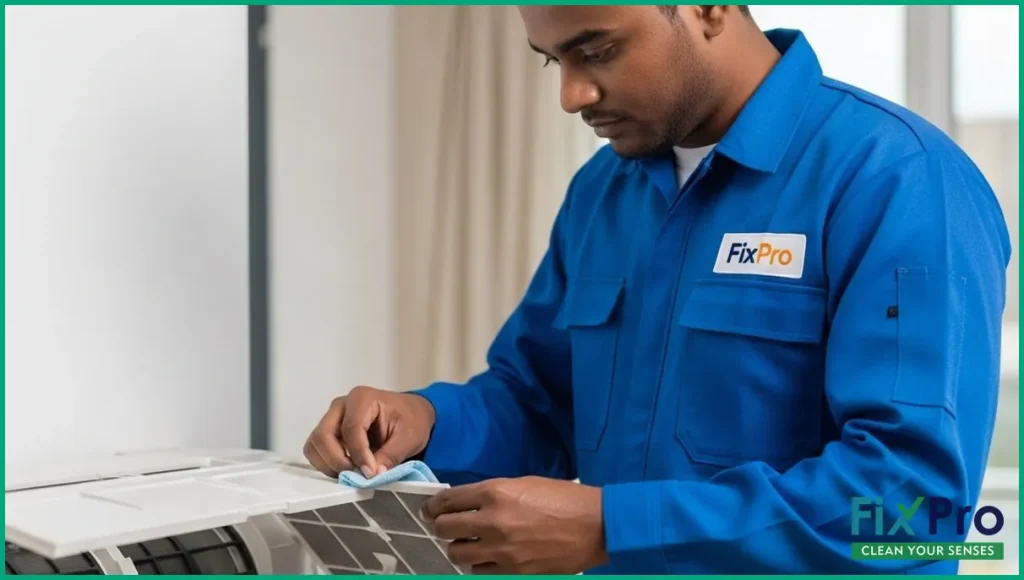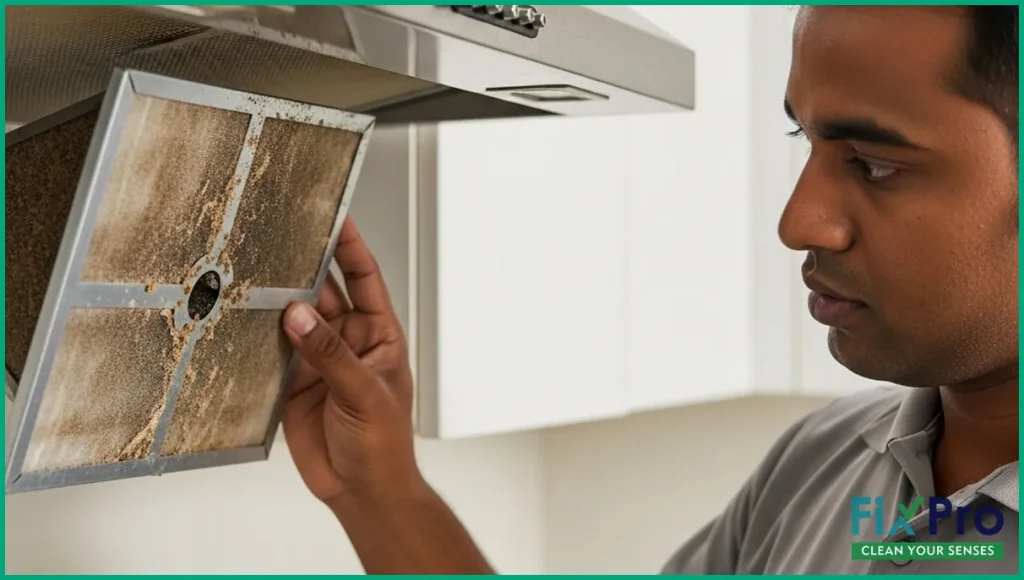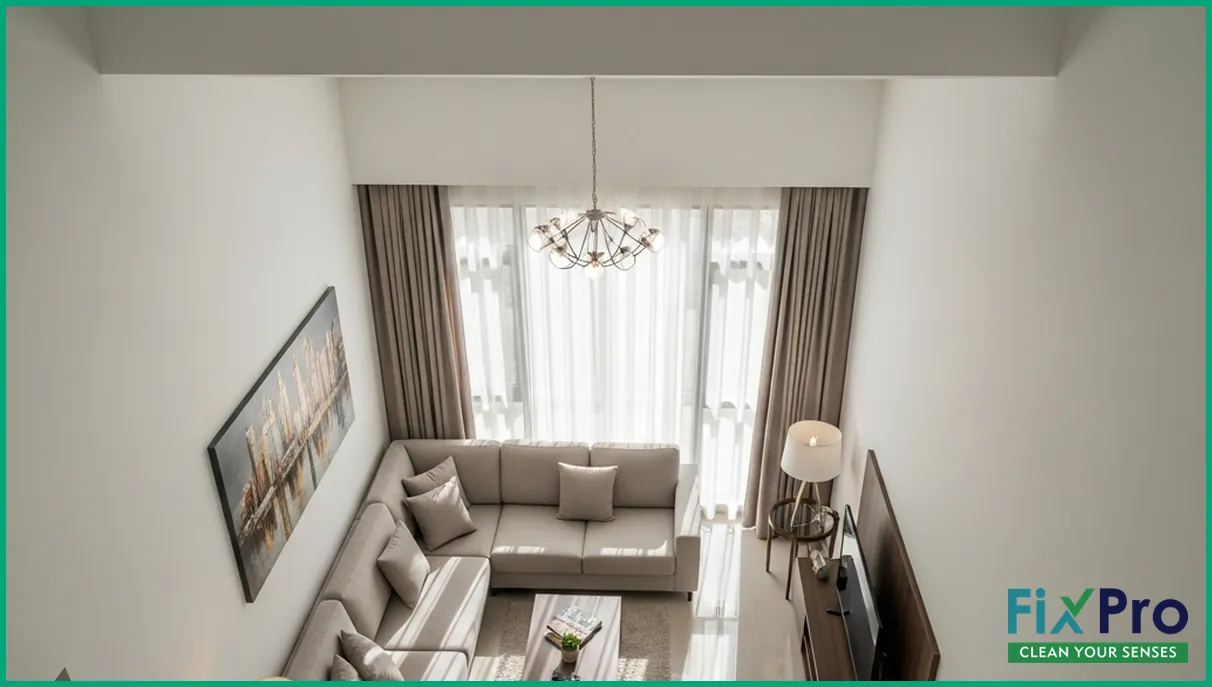
Understanding AC Duct Issues in Abu Dhabi
The climate in Abu Dhabi puts AC systems under heavy strain. Over time, dust, humidity, and constant use can lead to a range of duct problems. These issues affect air quality, cooling efficiency, and even your electricity bills. Recognizing the early signs helps you avoid bigger headaches later. In addition, sandstorms and high outdoor temperatures mean that duct issues can develop more rapidly than in cooler climates, making regular checks even more important here.
Common Signs of AC Duct Problems
- Uneven cooling in different rooms, such as bedrooms feeling warmer than living areas
- Weak or warm airflow from vents, especially during peak afternoon heat
- Unusual noises when the AC runs, like rattling, whistling, or banging
- Visible dust buildup around vents, particularly after a sandstorm
- Musty or stale smells, often strongest when you first turn on the AC
- Increased allergy symptoms or respiratory discomfort among family members
- Higher-than-usual electricity bills without increased AC usage
- Water stains or discoloration around ceiling vents, indicating possible leaks
If you notice any of these symptoms, your AC ducts may need inspection or cleaning. Persistent problems often point to underlying duct blockages, leaks, or even mold growth. In some cases, you may also notice condensation on or near vents, which can be an early warning sign of insulation or moisture issues inside the ducts.
Quick Troubleshooting Steps for Homeowners
1. Check Airflow and Vents
Walk through your home and feel the air coming from each vent. If some rooms are warmer or airflow is weak, note which vents are affected. Remove vent covers and check for visible dust or debris. Use a flashlight to look inside the duct opening for blockages like clumps of dust, pet hair, or even small objects that may have fallen in. If you have a two-story home, compare airflow upstairs and downstairs—sometimes upper floors suffer more due to duct design or blockages.
2. Inspect AC Filters
Dirty filters can mimic duct issues by restricting airflow. Replace or clean filters as recommended by your AC unit’s manual. For many Abu Dhabi homes, this means every 1–2 months, especially during dusty seasons or if you have pets. Always turn off your AC before removing the filter to avoid drawing dust into the system. If airflow doesn’t improve after cleaning or replacing the filter, the ducts may be the culprit.
3. Listen for Unusual Sounds
Rattling, whistling, or banging noises when the AC runs can signal loose ductwork or obstructions. Pay attention to where the sound comes from—it helps pinpoint the problem area. For example, a whistling sound near a particular vent may indicate a leak or a gap in the duct behind that vent. If you hear metallic clanging, it could be a loose duct section or even a small object trapped inside.
4. Look for Moisture and Mold
Excess moisture around vents or musty smells hint at possible mold growth inside ducts. In Abu Dhabi’s humid climate, this is a real concern and should be addressed quickly. Use a tissue or paper towel to check for dampness near vents or on the ceiling. If you spot black or greenish spots inside or around the vent, this could be mold—avoid touching it directly and ventilate the area until a professional can inspect.
5. Prepare for a Thorough Check
Before starting any troubleshooting, gather basic supplies: a flashlight, screwdriver (for vent covers), gloves, and a dust mask. For apartments, notify building management if you need to access shared ductwork or roof units. For villas, check outdoor AC units for visible blockages like leaves or sand, which can also impact duct performance. Taking photos of problem areas can help professionals diagnose issues faster if you need to call for help later.
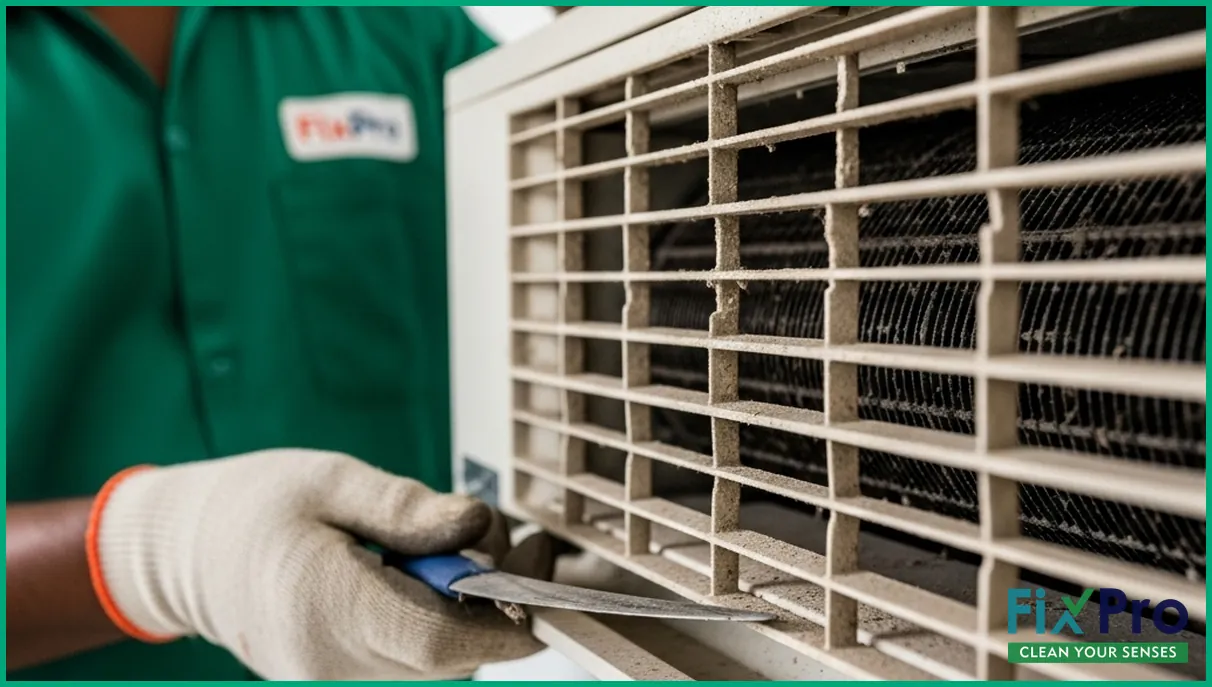
6. Test with Tissue Paper
Hold a tissue or thin piece of paper up to the vents while the AC is running. If the tissue barely moves or gets sucked against the vent, airflow is weak and may indicate a blockage. This simple test can help you compare airflow between rooms and identify which ducts need closer inspection.
Typical AC Duct Issues in Abu Dhabi Homes
| Issue | Common Cause | DIY Action |
|---|---|---|
| Weak Airflow | Dust buildup or blocked ducts | Check and replace filters; inspect vents; vacuum accessible duct openings |
| Uneven Cooling | Leaky or disconnected ducts | Seal visible leaks with duct tape; adjust vent direction; balance dampers if accessible |
| Strange Odors | Mold or stagnant water in ducts | Clean vents; consult a professional; run AC on “fan only” mode to help dry ducts |
| Loud Noises | Loose ductwork or debris inside | Tighten accessible connections; remove visible debris; pad loose metal with insulation tape |
| Water Leaks | Condensation or blocked drain pipes | Clear drain lines if accessible; dry affected areas; call a technician if problem recurs |
| Persistent Dust | Poor sealing, gaps, or nearby construction dust entering ducts | Seal gaps; use higher-quality filters; clean surrounding areas regularly |
While some issues can be managed with basic maintenance, others—like persistent odors or visible mold—require professional help. Fixpro recommends regular ac duct cleaning for healthy indoor air. If you live near construction zones or open desert, consider cleaning ducts more frequently, as fine sand can accumulate quickly and block airflow.
When to Call for Professional AC Unit Maintenance
If your troubleshooting doesn’t solve the problem, or if you spot mold, water leaks, or disconnected ducts, it’s time to call a specialist. Professionals have the tools to inspect inside ducts, locate hidden leaks, and remove stubborn blockages safely. They can also sanitize ductwork to eliminate mold, bacteria, and allergens—important for families with young children or elderly residents.
- Air remains weak after filter changes and vent checks
- Strange smells persist after basic cleaning
- Visible mold, mildew, or water stains near or inside vents
- Repeated duct noises even after tightening accessible connections
- Signs of pests (such as droppings or scratching sounds) inside ducts
- Unexplained spikes in electricity bills despite normal usage
- Recent home renovations that may have introduced debris into the ductwork
- Recurring condensation or moisture problems, especially on ceilings near vents
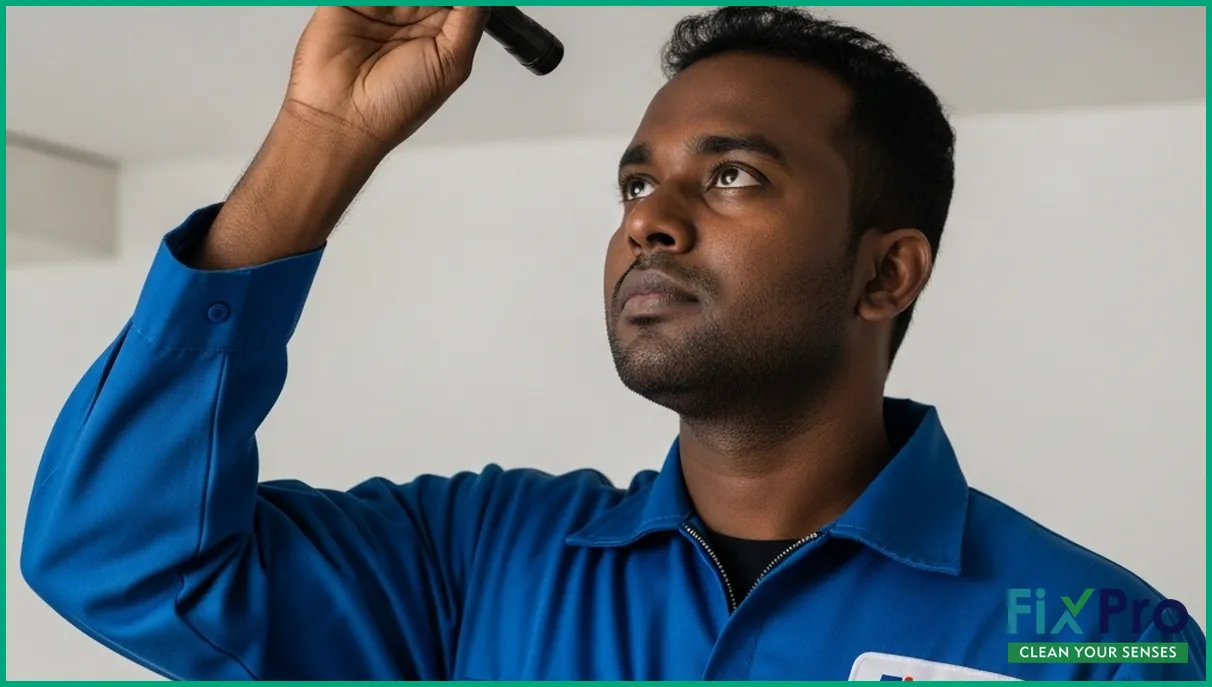
In Abu Dhabi, regular ac duct cleaning and HVAC maintenance are commonly recommended, especially in homes with pets, allergies, or frequent AC use. Many service providers offer quick-response visits for urgent issues during the summer months, when AC problems can escalate fast.
Before the technician arrives, clear access to vents and indoor AC units, and make a list of symptoms and any troubleshooting steps you’ve already taken. This helps speed up diagnosis and repair, saving you time and money.
Preventive Tips: Keeping Your AC Ducts Healthy
- Change or clean filters every 1–3 months, or more often if you notice dust buildup
- Keep vents clear of furniture, curtains, and dust to ensure free airflow
- Schedule annual duct inspections before peak summer to catch problems early
- Seal visible duct leaks with appropriate tape or mastic sealant for a longer-lasting fix
- Consider a maintenance contract for peace of mind and regular professional checks
- Vacuum vent covers and surrounding areas weekly, especially after sandstorms
- Install vent deflectors to help direct airflow and balance temperatures in larger rooms
- Ensure outdoor AC units are free of sand, leaves, and debris to prevent strain on ducts
- Ask your technician to check duct insulation, which helps prevent condensation and energy loss
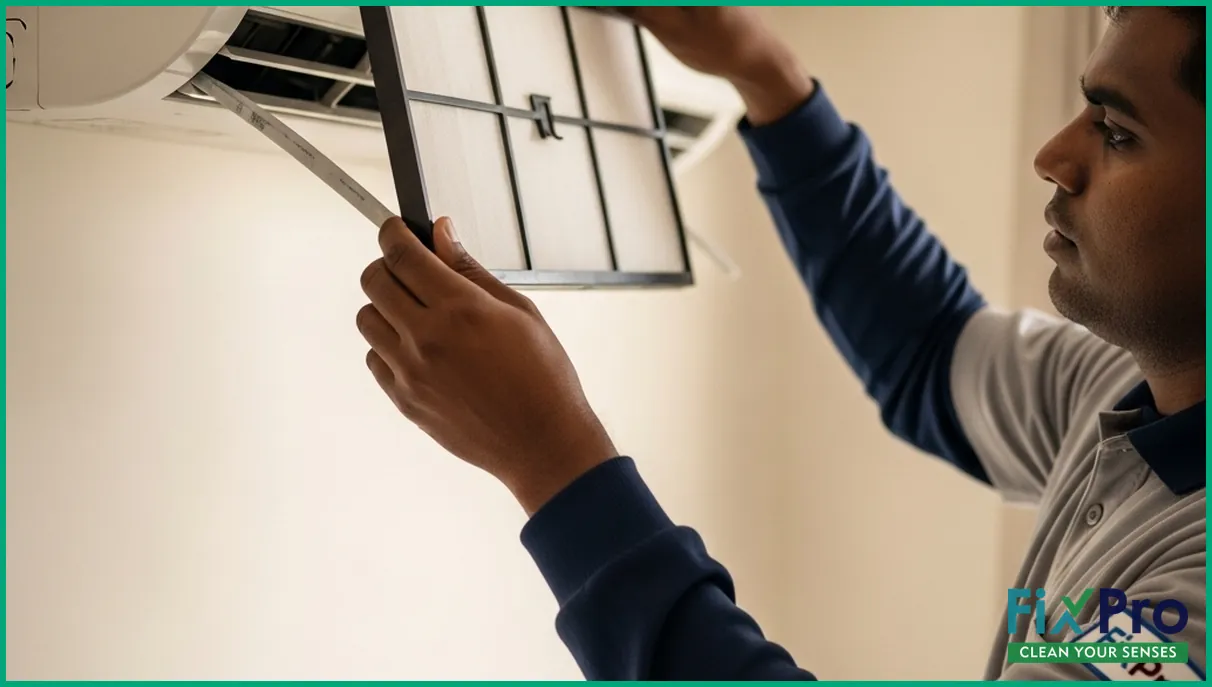
Fixpro offers flexible AMC contract options for ongoing maintenance, which can help catch duct issues before they become costly repairs. For families with children or elderly members, regular maintenance is especially important to ensure healthy indoor air and comfort.
For added peace of mind, ask your maintenance provider about eco-friendly cleaning products and HEPA-grade filters, which can further improve air quality in your home.
FAQs: AC Duct Issues in Abu Dhabi
How often should I clean my AC ducts?
Every 1–2 years is typical, but homes with pets or allergies may need more frequent cleaning. If you live near a construction site or in a high-traffic area, consider cleaning ducts annually. After major renovations, a one-time duct cleaning is also recommended to remove dust and debris.
Can dirty ducts increase my electricity bill?
Yes, blocked ducts make your AC work harder, using more energy and raising bills. Even a thin layer of dust can reduce efficiency by up to 20%. If you notice your AC running longer than usual or struggling to cool, check the ducts and filters.
Is duct cleaning safe for all AC systems?
Usually yes, but always check your AC unit manual or consult a professional first. Some older or delicate systems may require gentler cleaning methods, such as low-pressure vacuuming instead of brushing. It’s best to ask your technician about the safest approach for your specific system.
What’s the difference between duct cleaning and HVAC maintenance?
Duct cleaning targets air passages, while HVAC maintenance covers the whole system. Maintenance includes checking refrigerant levels, electrical connections, and thermostat function, in addition to cleaning. For best results, combine both services at least once a year.
Can I use household cleaners inside my ducts?
It’s not recommended. Some chemicals can linger and affect air quality. Always use products approved for HVAC systems, and avoid bleach or harsh sprays that can damage duct linings or leave harmful residues. If you suspect mold, call a professional for safe removal.
Are there regional differences in duct issues within Abu Dhabi?
Yes, coastal areas may experience more humidity-related duct issues, while desert-edge neighborhoods often deal with more dust and sand intrusion. High-rise apartments sometimes have centralized duct systems, which can complicate access and require building management approval for inspection or cleaning. Villas with rooftop AC units may be more prone to leaks due to direct sun exposure.
Can I improve air quality by pairing AC use with other methods?
Absolutely. Use air purifiers, keep windows closed during sandstorms, and place doormats at entrances to reduce dust. Pairing AC use with regular dusting, mopping, and even using indoor plants can help maintain cleaner air and reduce the load on your ducts.
What are some practical serving suggestions for a cool, comfortable home?
After AC duct cleaning, enjoy the improved air quality by hosting a gathering or family meal in your freshly cooled living room. Pair the comfort of your clean, cool home with fresh bread, light salads, and cold drinks for a relaxing evening. For added comfort, use light cotton curtains and rugs to keep rooms feeling fresh and airy.
What should I do if my AC smells after cleaning the ducts?
If strange odors persist after duct cleaning, check for leftover moisture, blocked drain lines, or mold in hidden areas. Run your AC on “fan only” mode for a few hours to help dry out the ducts. If the smell continues, call a professional to inspect for deeper issues.
Next Steps
If your AC duct issue persists after these checks, schedule a professional inspection to prevent bigger problems. For homes with kitchen ventilation concerns, explore kitchen exhaust cleaning as part of your maintenance routine. Remember, a well-maintained AC system not only cools efficiently but also creates a healthier, more enjoyable living space for you and your family.
Stay proactive, keep a maintenance calendar, and don’t hesitate to reach out to local experts for advice tailored to your neighborhood and home type.
